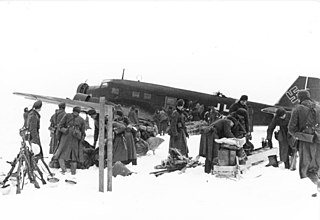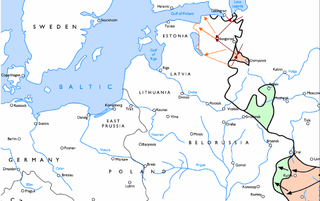Eastern Front
Axis
In alphabetic order
- Aktion 24 (1945)
 — largely unsuccessful attempts to use Mistels and explosive-laden Do 24s to destroy strategic river bridges
— largely unsuccessful attempts to use Mistels and explosive-laden Do 24s to destroy strategic river bridges - Aster (1944)
 — withdrawal from Estonia.
— withdrawal from Estonia. - Barbarossa ("Red Beard" was the nickname for Emperor Frederick I) (1941)





 — invasion of the Soviet Union.
— invasion of the Soviet Union. - Haifisch ("Shark") (1941)
 — deception operation for Barbarossa, feint on Scotland and north-east England from Norway.
— deception operation for Barbarossa, feint on Scotland and north-east England from Norway. - Harpune ("Harpoon") (1941)
 — deception operation for Barbarossa, feint on southern England from France.
— deception operation for Barbarossa, feint on southern England from France. - München ("Munich") (1941)

 — joint German-Romanian offensive of Bessarabia and Northern Bukovina.
— joint German-Romanian offensive of Bessarabia and Northern Bukovina. - Taifun ("Typhoon") (1941)
 — offensive to capture Moscow before winter.
— offensive to capture Moscow before winter.
- Haifisch ("Shark") (1941)
- Beowulf I & II (Heroic figure) (1941)
 — two separate plans to assault the Estonian islands of Saaremaa, Hiiumaa and Muhu
— two separate plans to assault the Estonian islands of Saaremaa, Hiiumaa and Muhu - Nordwind ("Northern wind") (1941)

 — Diversionary plan for Beowulf II
— Diversionary plan for Beowulf II - Siegfried (Heroic figure)(1941)
 — German assault on Hiiumaa
— German assault on Hiiumaa - Südwind ("Southern wind") (1941)
 — Diversionary plan for Beowulf II
— Diversionary plan for Beowulf II - Weststurm ("Western Storm") (1941)
 — naval bombardment in support of Beowulf II
— naval bombardment in support of Beowulf II - Westwind (1941)
 — Diversionary plan for Beowulf II
— Diversionary plan for Beowulf II - Edelweiss (1942)
 — advance through the Caucasus to the Baku oil fields and Black Sea coast
— advance through the Caucasus to the Baku oil fields and Black Sea coast - Kreml ("Kremlin") (1942)
 — deception operation to conceal southern offensive
— deception operation to conceal southern offensive
- Nordwind ("Northern wind") (1941)
- BLAU ("BLUE") (1942)
 — Umbrella name for drive towards southern Soviet Union.
— Umbrella name for drive towards southern Soviet Union. - Blücher ("after Gebhard Leberecht von Blücher") (1942)

 — campaign into the Caucasus
— campaign into the Caucasus - Braunschweig ("Brunswick") (1942)
 — drive towards Stalingrad and the Caucasus.
— drive towards Stalingrad and the Caucasus. - Fischreiher ("Heron") (1942)
 — offensive to capture Stalingrad.
— offensive to capture Stalingrad. - Hubertus (1942)
 — attack against Stalingrad [ citation needed ]
— attack against Stalingrad [ citation needed ]- Wintergewitter ("Winter Storm") (1942)

 — attempt to relieve encircled 6th Army at Stalingrad by Army Group Don.
— attempt to relieve encircled 6th Army at Stalingrad by Army Group Don. - Donnerschlag ("Thunderclap") (1942)
 — planned breakout of the Sixth Army.
— planned breakout of the Sixth Army. - Dietrich (1942)
 — planned counter-attack to relieve Sixth Army using SS panzer divisions Grossdeutschland & Leibstandarte Adolf Hitler. Unimplemented.
— planned counter-attack to relieve Sixth Army using SS panzer divisions Grossdeutschland & Leibstandarte Adolf Hitler. Unimplemented.
- Wintergewitter ("Winter Storm") (1942)
- Fischreiher ("Heron") (1942)
- Blücher ("after Gebhard Leberecht von Blücher") (1942)
- Delphin ("Dolphin") (1943)
 — German withdrawal from Saaremaa, Estonia.
— German withdrawal from Saaremaa, Estonia. - Eisenhammer ("Iron Hammer") (1943)
 — abandoned plan to attack Soviet power plants power generators near Moscow and Gorky, using Mistel composite aircraft, abandoned in 1945.
— abandoned plan to attack Soviet power plants power generators near Moscow and Gorky, using Mistel composite aircraft, abandoned in 1945. - Eisstoss ("Ice Push") (1941)
 — Luftwaffe raids on Soviet warships near Leningrad including;
— Luftwaffe raids on Soviet warships near Leningrad including; - Froschlaich ("FrogSpawn") (1941) - air raids against Soviet Navy yards at Leningrad, USSR; part of Operation Eisstoss
- Götz v. Berlichingen (a knight in the Swabian war) (1941) - air raids against Soviet Navy at Leningrad, USSR; part of Operation Eisstoss
- Feuerzauber ("Fire Magic") (1942)
 — planned capture of Leningrad
— planned capture of Leningrad - Flamingo (1942)
 — planting of Mishinskii as German agent in Soviet military hierarchy
— planting of Mishinskii as German agent in Soviet military hierarchy - Frühlingserwachen ("Spring Awakening") (1945)

 — counterattack against Soviets in Hungary. Last major offensive on Eastern Front.
— counterattack against Soviets in Hungary. Last major offensive on Eastern Front. - Hannibal (1945)
 — evacuation of East Prussia
— evacuation of East Prussia - Joseph (1944)
 — proposal to destroy electricity supplies to Moscow
— proposal to destroy electricity supplies to Moscow - Konrad (1945)

 — German-Hungarian efforts to relieve the encircled garrison in Budapest
— German-Hungarian efforts to relieve the encircled garrison in Budapest - Laura (1944)
 — proposed evacuation of Courland
— proposed evacuation of Courland - Margarethe (1944)
 — military operation to keep Hungary from defecting
— military operation to keep Hungary from defecting - Narwa I II III (1942/43)
 — sabotage operations behind Soviet lines
— sabotage operations behind Soviet lines - Nordlicht ("Northern Lights") (1942)
 — planned assault on Leningrad —
— planned assault on Leningrad — - Polikov (1942/43)
 — sabotage operations behind Soviet lines
— sabotage operations behind Soviet lines - Rennstrecke (1944)
 — planned air supply of German troops isolated behind Soviet lines (later found out as a Soviet deception)
— planned air supply of German troops isolated behind Soviet lines (later found out as a Soviet deception) - Salzsee (1944)
 — sabotage operations in Kalmykia, USSR
— sabotage operations in Kalmykia, USSR - Schamil (1942)
 —
— - Sonnenwende ("Winter Solstice") (1945)
 — offensive in Pomerania to stall the advance on Berlin
— offensive in Pomerania to stall the advance on Berlin - Südwind ("South Wind") (1945)
 — offensive in Hungary to eliminate the Soviet bridgehead west of the Garam
— offensive in Hungary to eliminate the Soviet bridgehead west of the Garam - Trappenjagd ("Bustard Hunt") (1942)

 — offensive in the Kerch Peninsula
— offensive in the Kerch Peninsula - Wilddieb (1944)
 — RSHA operation to monitor radio traffic from isolated German troops
— RSHA operation to monitor radio traffic from isolated German troops - Wolf (1942/43)
 — sabotage operations behind Soviet lines
— sabotage operations behind Soviet lines - Wunderland ("Wonderland") (1942)
 —
— - Zauberflöte (1943)
 — Joint Wehrmacht / SS Police security operation in Minsk, Belarus
— Joint Wehrmacht / SS Police security operation in Minsk, Belarus - Zitadelle ("Citadel") (1943)
 — German offensive at Kursk
— German offensive at Kursk
Soviet Union
Operations listed here are some of the better known strategic operations of the Red Army in World War II, and exclude operations by partisans or "Home Armies". These are included under List of World War II military operations. Names of other operations have not been recorded and these have become known by their regional objective. [1]
In alphabetic order
- Bagration (1944)
 — successful large-scale offensive in Belorussia.
— successful large-scale offensive in Belorussia. - Belgrade Offensive (1944)
 — successful offensive to disrupt the German occupation of Yugoslavia and seize Belgrade.
— successful offensive to disrupt the German occupation of Yugoslavia and seize Belgrade. - Battle of Berlin (1945)
 — successful offensive to take Berlin.
— successful offensive to take Berlin. - Bratislava–Brno Offensive (1945)
 — successful offensive to take Bratislava and Brno.
— successful offensive to take Bratislava and Brno. - Budapest Offensive (1944) & (1945)
 — successful offensive to take Budapest.
— successful offensive to take Budapest. - Iskra ("Spark") (1943)
 — successful Soviet counter-offensive around Leningrad
— successful Soviet counter-offensive around Leningrad - Jassy–Kishinev Offensive (August 1944)
 — successful offensive causing Romania to switch allegiance to the Allies.
— successful offensive causing Romania to switch allegiance to the Allies. - Kutuzov (1943)
 — attack on 2nd Panzer Army, in Orel region north of the Kursk salient
— attack on 2nd Panzer Army, in Orel region north of the Kursk salient - Lyuban (1942)
 — failed attempt to relieve Leningrad.
— failed attempt to relieve Leningrad. - Mars (1942)
 — failed major offensive against Rzhev salient
— failed major offensive against Rzhev salient - Polar Star (1943)
 — offensive to destroy Army Group North.
— offensive to destroy Army Group North. - Polkovodets Rumyantsev (1943)
 — defeat of Army Group South's 4th Panzer Army and Army Detachment Kempf.
— defeat of Army Group South's 4th Panzer Army and Army Detachment Kempf. - Prague Offensive (1945)
 — Soviet offensive in final stages of World War II
— Soviet offensive in final stages of World War II - Ring (1943)
 — Destruction of the encircled army at Stalingrad.
— Destruction of the encircled army at Stalingrad. - Samland (1945)
 — capture of Königsberg.
— capture of Königsberg. - Saturn (1942)
 — Proposed major attack following the Stalingrad encirclement; revised to Little Saturn.
— Proposed major attack following the Stalingrad encirclement; revised to Little Saturn. - Sinyavino (1941) & (1942)
 — separate failed Soviet attempts to relieve Leningrad
— separate failed Soviet attempts to relieve Leningrad - Suvorov (1943)
 — recapture of Spas-Demensk, El’nia, Roslavl’, and Smolensk.
— recapture of Spas-Demensk, El’nia, Roslavl’, and Smolensk. - Uranus (1942)
 — successful Soviet encirclement of German Sixth Army in Stalingrad.
— successful Soviet encirclement of German Sixth Army in Stalingrad. - Vienna Offensive (1945)
 — successful offensive to take Vienna.
— successful offensive to take Vienna. - Vistula–Oder Offensive (1945)
 — successful offensive in Poland and Germany from the Vistula to the Oder.
— successful offensive in Poland and Germany from the Vistula to the Oder.








